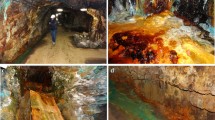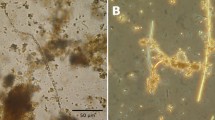Abstract
Treatment of acidic iron- and sulfate-rich mine waters in a pilot plant at the opencast lignite mining pit Nochten (Lusatia, Germany) involves microbial iron oxidation and subsequent precipitation of the iron-oxyhydroxysulfate schwertmannite. To determine if recirculation of schwertmannite can stabilize and optimize the oxidation process, cell number, viability, and diversity of the bacterial community in schwertmannite precipitated on carrier material and stored schwertmannite were analyzed. In schwertmannite on carrier material, the total cell number decreased slightly with increasing mineral depth, whereas the percentage of viable cells decreased significantly. The microbial community, investigated by fluorescence-in-situ-hybridization (FISH) and terminal restriction fragment length polymorphism (T-RFLP), revealed the presence of the iron-oxidizing bacterium “Ferrovum” sp. and relatives of Gallionella, independent of mineral depth. Analysis of the viability of microorganism in stored schwertmannite indicated an almost constant percentage of viable cells over 42 days.
Zusammenfassung
Am Tagebau Nochten (Lausitz, Deutschland) werden saure Eisen- und sulfatreiche Bergbauwässer in einer Pilotanlage biotechnologisch behandelt. Die Eisenkonzentration wird durch mikrobielle Eisenoxidation mit anschließender Präzipitation des Eisen(III)-oxyhydroxysulfates Schwertmannit reduziert. Eine Stabilisierung und Optimierung des Oxidationsprozesses soll durch eine Rückführung des Schwermannits erreicht werden. Um die Machbarkeit dieser in Betracht gezogenen Strategie beurteilen zu können, wurden die Zellzahl, die Lebensfähigkeit und die Zusammensetzung der bakteriellen Lebensgemeinschaft in auf Aufwuchsträgern präzipitierten und in gelagertem Schwertmannit analysiert. In dem auf Aufwuchsträgern präzipitieren Schwertmannit konnte eine nur leichte Abnahme der Gesamtzellzahl innerhalb des Mineralpräzipitates festgestellt werden, wohingegen der Anteil der lebenden Zellen mit steigender Mineraltiefe signifikant abnahm. Die mikrobielle Lebensgemeinschaft, die mittels Fluoreszenz-in-situ-Hybridisierung (FISH) und terminalen Restriktionsfragmentlängen-Polymorphismus (T-RFLP) analysiert wurde, wurde unabhängig von der Mineraltiefe von dem eisenoxidierenden Bakterium „Ferrovum“ sp. und Gallionella-Verwandten dominiert. In gelagertem Schwertmannit wurde über 42 Tage ein nahezu konstanter Anteil an lebenden Zellen im Mineral detektiert.
Resumen
El tratamiento de aguas ácidas ricas en hierro y sulfato en una planta piloto en el hoyo de la mina de lignita a cielo abierto Nochten (Lusatia, Alemania) involucra oxidación microbiana de hierro y la subsecuente precipitación del oxohidroxo sulfato de hierro schwertmannita. Para determinar si la recirculación de schwertmannita puede estabilizar y optimizar el proceso de oxidación, se analizaron el número de células, la viabilidad y la diversidad en la comunidad bacteriana en el precipitado de schwertmannita sobre material portador y en schwertmannita almacenada. En la schwertmannita sobre material portador, el número total de células decreció ligeramente con el incremento de la profundidad en el mineral mientras que el porcentaje de células viables decreció significativamente. La comunidad microbiana, investigada por hibridación fluorescente in situ (FISH) y polimorfismo de la longitud de los fragmentos terminales de restricción (T-RFLP), revelaron la presencia de bacterias hierro oxidantes Ferrovum sp y cercanas a Gallionella, independiente de la profundidad del mineral. El análisis de la viabilidad de microorganismos en la schwertmannita almacenada indicó un porcentaje casi constante de células viables durante 42 días.
抽象
富铁、富硫酸盐酸性矿井水处理在德国卢萨西亚(Lusatia)萨克森(Nochten)褐煤露天矿小型试验场进行,该类水处理需经历铁微生物氧化及随后的次生羟基硫酸高铁矿物施氏矿(Schwertmannite)沉降两个重要过程。为了确定施氏矿的再循环处理是否能稳定和优化氧化过程,研究了沉积于载体材料的和预存的施氏矿的菌落细胞数量、生物活性和菌落多样性。载体材料上的施氏矿总体细胞数量随沉积矿物深度增加而略微减少,活细胞的百分比减少更加明显。利用荧光原位杂交(FISH)和末端限制性片段长度多态性(T-RFLP)方法分析了菌群特征,铁氧化细菌(Ferrovum sp.)和亲缘微生物Gallionella的存在与沉积矿物深度无关。预存施氏矿的微生物活性研究表明,其活性细胞比例在42天之后仍能保持稳定。





Similar content being viewed by others
References
Banks D, Younger P, Amesen RT, Iversen E, Banks SB (1997) Mine-water chemistry: the good, the bad and the ugly. Environ Geol 32(3):157–174
Boulos L, Prévost M, Barbeau B, Coallier J, Desjardins R (1999) LIVE/DEAD® BacLight™: application of a new rapid staining method for direct enumeration of viable and total bacteria in drinking water. J Microbiol Methods 37(1):77–86
Brock T, Gustafson J (1976) Ferric iron reduction by sulfur- and iron-oxidizing bacteria. Appl Environ Microbiol 32(4):567–571
Ferris FG, Hallbeck L, Kennedy CB, Pedersen K (2004) Geochemistry of acidic Rio Tinto headwaters and role of bacteria in solid phase metal partitioning. Chem Geol 212(3–4):291–300
Fournier D, Lemieus R, Couillard D (1998) Essential interactions between Thiobacillus ferrooxidans and heterotrophic microorganisms during a wastewater sludge bioleaching process. Environ Pollut 101(2):303–309
Fuchs BM, Glockner FO, Wulf J, Amann R (2000) Unlabeled helper oligonucleotides increase the in situ accessibility to 16S rRNA of fluorescently labeled oligonucleotide probes. Appl Environ Microbiol 66(8):3603–3607
Glombitza F, Janneck E, Arnold I, Rolland W, Uhlmann W (2007) Eisenhydroxysulfate aus der Bergbauwasserbehandlung als Rohstoff. In: Consulting-Erfahrungen und Kontakte für Neuanfänge -Untertägiger Bergbau auf Industrieminerale in Deutschland, GDMB Gesellschaft für Bergbau, Metallurgie, Rohstoff- und Umwelttechnik e.V., GDMB Medienverlag: Clausthal-Zellerfeld, Germany, pp 31–40 (in German)
Gonzalez-Toril E, Aguilera A, Souza-Egipsy V, Lopez Pamo E, Sanchez Espana J, Amils R (2011) Geomicrobiology of La Zarza-Perrunal acid mine effluent (Iberian Pyritic Belt, Spain). Appl Environ Microbiol 77(8):2685–2694
Hallberg KB, Coupland K, Kimura S, Johnson DB (2006) Macroscopic streamer growths in acidic, metal-rich mine waters in North Wales consist of novel and remarkably simple bacterial communities. Appl Environ Microbiol 72(3):2022–2030
Hallmann R, Friedrich A, Koops H, Pommerening-Röser A, Rohde K, Zenneck C, Sand W (1992) Physiological characteristics of Thiobacillus ferrooxidans and Leptospirillum ferrooxidans and physicochemical factors influence microbial metal leaching. Geomicrobiol J 10(3–4):193–206
Hamamura N, Olson SH, Ward DM, Inskeep WP (2005) Diversity and functional analysis of bacterial communities associated with natural hydrocarbon seeps in acidic soils at Rainbow Springs, Yellowstone National Park. Appl Environ Microbiol 71(10):5943–5950
Hanert H (1968) Untersuchungen zur Isolierung, Stoffwechselphysiologie und Morphologie von Gallionella ferruginea Ehrenberg. Arch Mikrobiol 60(4):348–376
Harrison AP Jr (1984) The acidophilic Thiobacilli and other acidophilic bacteria that share their habitat. Annu Rev Microbiol 38(1):265–292
Hedrich S, Johnson DB (2012) A modular continuous flow reactor system for the selective bio-oxidation of iron and precipitation of schwertmannite from mine-impacted waters. Bioresour Technol 106:44–49
Hedrich S, Heinzel E, Seifert J, Schlömann M (2009) Isolation of novel iron-oxidizing bacteria from an acid mine water treatment plant. Adv Mat Res 71–72:125–128
Hedrich S, Lünsdorf H, Kleeberg R, Heide G, Seifert J, Schlömann M (2011) Schwertmannite formation adjacent to bacterial cells in a mine water treatment plant and in pure cultures of Ferrovum myxofaciens. Environ Sci Technol 45(18):7685–7692
Heinzel E, Hedrich S, Janneck E, Glombitza F, Seifert J, Schlömann M (2009a) Bacterial diversity in a mine water treatment plant. Appl Environ Microbiol 75(3):858–861
Heinzel E, Janneck E, Glombitza F, Schlömann M, Seifert J (2009b) Population dynamics of iron-oxidizing communities in pilot plants for the treatment of acid mine waters. Environ Sci Technol 43(16):6138–6144
Janneck E, Arnold I, Koch T, Meyer J, Burghardt D, Ehinger S (2010) Microbial synthesis of schwertmannite from lignite mine water and its utilization for removal of arsenic from mine waters and for production of iron pigments. In: Wolkersdorfer C, Freund A (eds) Mine water and innovative thinking. Proceedings of the international mine water association symposium, Cape Breton University Press, Sydney, NS, Canada, pp 131–134
Johnson DB, McGinness S (1991) Ferric iron reduction by acidophilic heterotrophic bacteria. Appl Environ Microbiol 57(1):207–211
Johnson DB, Rolfe S, Hallberg KB, Iversen E (2001) Isolation and phylogenetic characterization of acidophilic microorganisms indigenous to acidic drainage waters at an abandoned Norwegian copper mine. Environ Microbiol 3(10):630–637
Kappler A, Schink B, Newman D (2005) Fe(III) mineral formation and cell encrustation by the nitrate-dependent Fe(II)-oxidizer strain BoFeN1. Geobiology 3:235–245
Kimura S, Bryan CG, Hallberg KB, Johnson DB (2011) Biodiversity and geochemistry of an extremely acidic, low-temperature subterranean environment sustained by chemolithotrophy. Environ Microbiol 13(8):2092–2104
Lane D (1991) 16S/23S rRNA sequencing. In: Goodfellow M (ed) EMG Stackebrandt. Nucleic acid techniques in bacterial systematics. Wiley, Chichester, pp 115–175
Marchand E, Silverstein J (2003) The role of enhanced heterotrophic bacterial growth on iron oxidation by Acidithiobacillus ferrooxidans. Geomicrobiol J 20(3):231–244
Marchesi J, Sato T, Weightman A, Martin T, Fry A, Hiom S (1998) Design and evalution of useful bacterium-specific PCR primers that amplify genes coding for bacterial 16S rRNA. Appl Environ Microbiol 64(6):795–799
Nordstrom D (2000) Advances in the hydrogeochemistry and microbiology of acid mine waters. Int Geol Rev 42(6):499–515
Okabayashi A, Wakai S, Kanao T, Sugio T, Kamimura K (2005) Diversity of 16S ribosomal DNA-defined bacterial population in acid rock drainage from a Japanese pyrite mine. J Biosci Bioeng 100(6):644–652
Okido M, Takakuwa T, Eskandarpour A, Ichino R, Iwai K (2008) Evaluation of selective separation of phosphorous components from plating baths using schwertmannite. ISIJ Int 48(5):685–689
Pronk J, Johnson DB (1992) Oxidation and reduction of iron by acidophilic bacteria. Geomicrobiol J 10(3–4):153–171
Schippers A, Hallmann R, Wentzien S, Sand W (1995) Microbial diversity in uranium mine waste heaps. Appl Environ Microbiol 61(8):2903–2935
v. Wintzingerode F, Göbel UB, Stackebrandt E (1997) Determination of microbial diversity in environmental samples: pitfalls of PCR-bases rRNA analysis. FEMS Microbiol Rev 21(3):213–229
Acknowledgments
We thank the Federal Ministry of Education and Research (BMBF) for funding the SURFTRAP project (Project: 03G0714B) within the Geotechnologien R&D program. Furthermore, we thank Mareen Moche for helping with the cell counting.
Author information
Authors and Affiliations
Corresponding author
Electronic supplementary material
Below is the link to the electronic supplementary material.
Rights and permissions
About this article
Cite this article
Tischler, J.S., Wiacek, C., Janneck, E. et al. Microbial Abundance in the Schwertmannite Formed in a Mine Water Treatment Plant. Mine Water Environ 32, 258–265 (2013). https://doi.org/10.1007/s10230-013-0250-8
Received:
Accepted:
Published:
Issue Date:
DOI: https://doi.org/10.1007/s10230-013-0250-8




